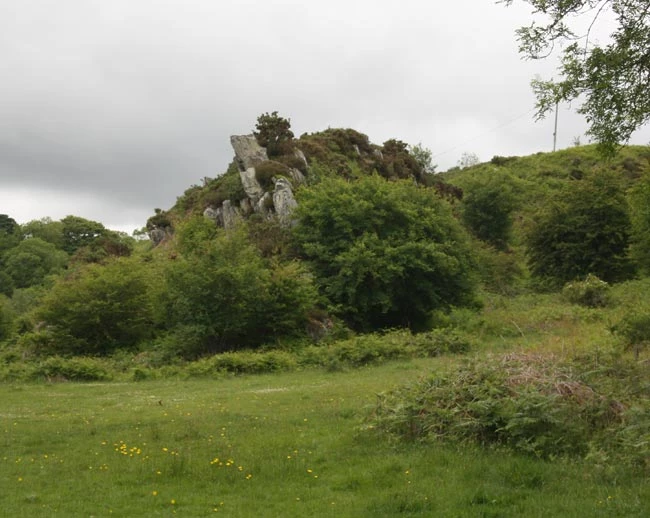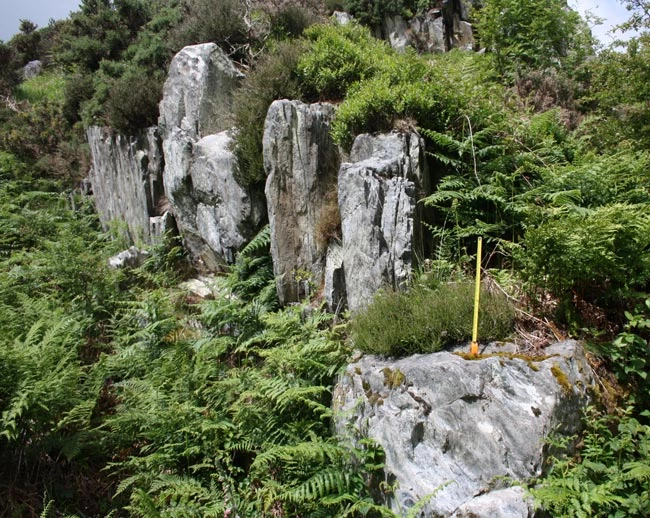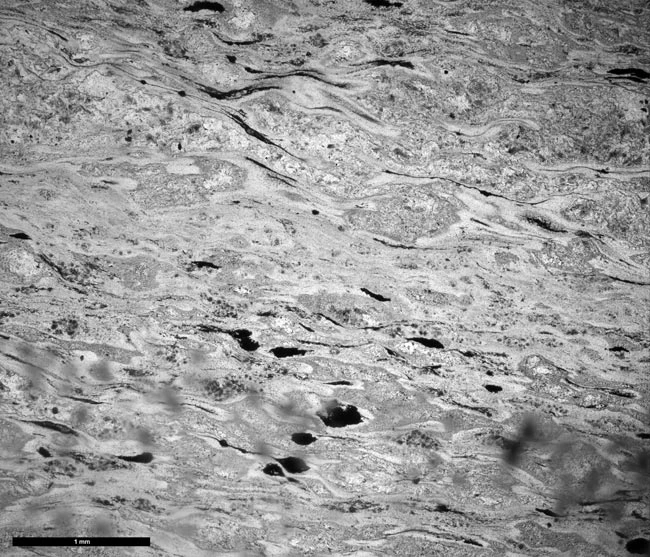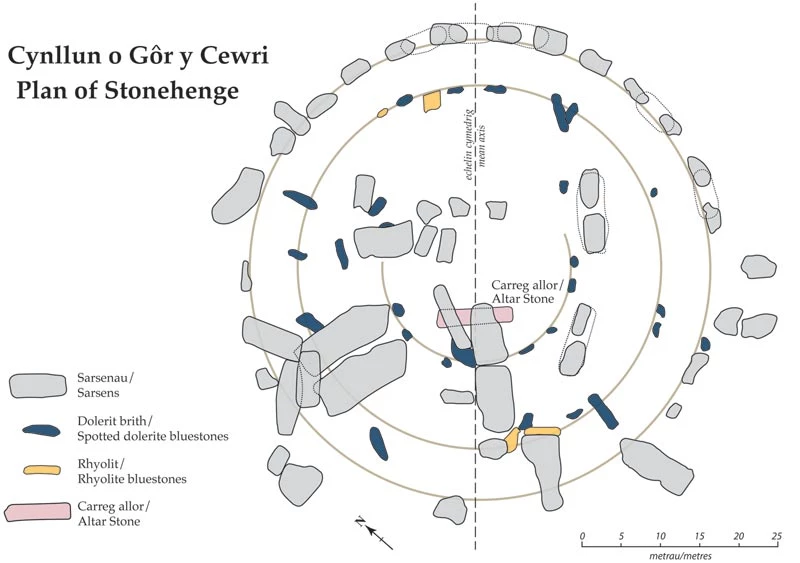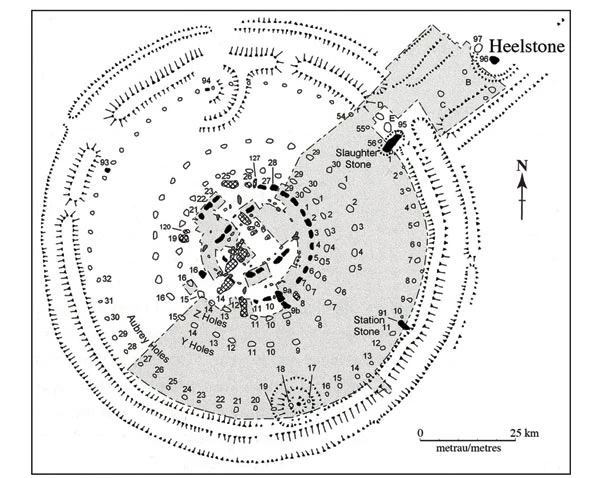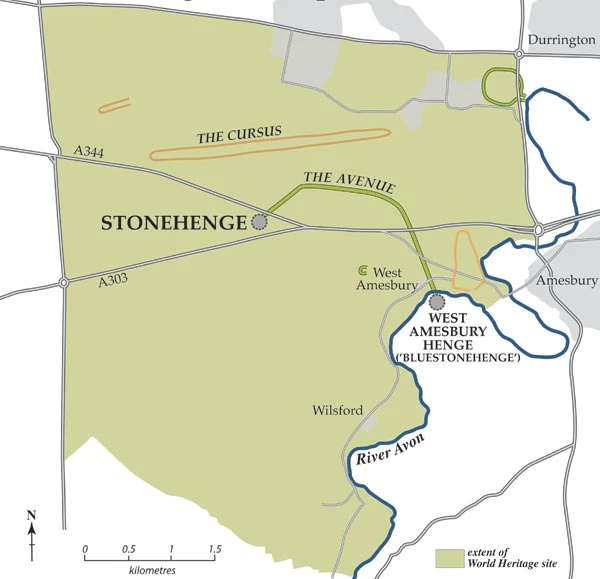Sourcing the Stonehenge Bluestones
Pont Saeson, June 2011.
Close up of the outcroppng rocks, Pont Saeson, June 2011.
Microscopic view of the newly identified match to the Stonehenge bluestones
The source of the Bluestones at Stonehenge has long been a subject of fascination and controversy. One type was traced to north Pembrokeshire in the early 1920s, but now geologists at Amgueddfa Cymru and University of Leicester have directly matched another type to a different part of north Pembrokeshire. Will this provide us with more ideas about how the stones might have been transported to Stonehenge?
The Stonehenge monument
Stonehenge, on Salisbury Plain, is one of the world's most iconic ancient monuments. It is designated as a UNESCO World Heritage Site, and it is as recognisable worldwide as sites such as Machu Picchu in Peru and the Xian Terracotta Warriors in China.
Stonehenge is a complex site. It is best known, of course, for the standing stones, which comprise the Outer Circle, the Inner Circle, the Inner Horseshoe and the Heel Stone and, within the structure, the so-called Altar Stone. Surrounding the stone circle are further structures, identified by mounds and ditches, and a series of 'holes' thought to have held standing stones of more henges. These holes, known as the Aubrey Holes, are important because they contain debris (or 'debitage' as some archaeologists call the material) whose lithology is not represented among the current standing stones. However, the current Stonehenge monument is only a part of a broader range of contemporary features, including the Avenue, the Cursus and the recently identified West Amesbury Henge (known as Bluestonehenge). Collectively, these comprise the Stonehenge Landscape.
The large stones that form the Outer Circle are known as 'Sarsens'. They are hard, resistant sandstones thought to have been collected from the local Salisbury Plain environment. The sources of the smaller stones that form the Inner Circle, the Inner Horseshoe and the Altar Stone, known as the 'Bluestones', are 'exotic' to the Salisbury Plain area. For many years their source baffled eminent Victorian investigators such as Maskelyne, Cunnington, Teal and Judd. This is the so-called Bluestone lithology.
The Bluestones
In 1923, however, H.H. Thomas from the Geological Survey published a paper in The Antiquaries Journal in which he claimed to have sourced the spotted dolerite component of the Bluestones to hilltop rock outcrops, or 'tors', exposed in the high Preseli, to the west of Crymych in west Wales. Specifically, he thought that the tors on Carn Meini and Carn Marchogion were the likely source outcrops. He went on to speculate about how humans had transported the stones to Salisbury Plain, favouring transport across land rather than a combined land and sea journey.
Not all the Bluestone stones standing today at Stonehenge, however, are spotted dolerites. Four of them are ash-flow tuffs, of either dacitic or rhyolitic composition. Debris recovered from the Aubrey Holes, as well as various archaeological excavations at Stonehenge and the Stonehenge Landscape, comprise spotted dolerite and more, and very different, dacitic and rhyolitic Bluestone material.
Map of the Preseli area showing the research area, and the proposed origins of the Bluestones
Plan of Stonehenge
Plan of Stonehenge showing archaeological detail
The Stonehenge Landscape
Recent discoveries
In 2009 Amgueddfa Cymru, in collaboration with Dr Rob Ixer, University of Leicester began new petrological investigations. Examination of debris from the Cursus Field, adjacent to the Cursus, showed the presence of samples identified as being ash-flow tuffs, with tube pumice, crystal fragments and lithic clasts in a fine-grained recrystallized matrix. These were broadly similar to the four dacitic and rhyolitic standing stones, yet showed key differences. Also present were samples that had previously been informally called 'rhyolite with fabric'. This lithology is defined by a very well-developed fabric, present on the millimetre scale. This distinctive rock texture has led Museum scientists to identify the source of the rock to Pont Saeson, in the low ground to the north of Mynydd Preseli.
Vaporising the Bluestones
To test this match further, quantitative evidence has been acquired by analysing the composition of tiny, micron-sized zircon crystals from Stonehenge and Pont Season rhyolite samples, using a technique known as 'laser ablation inductively coupled plasma mass spectrometry' at Aberystwyth University.
The technique is to focus a very high-power laser beam, with a diameter of only 10 microns, onto the zircon crystals (themselves no larger than 100 microns) and 'ablate' them — essentially vaporizing them — so that after analysis the zircon crystals are peppered with small craters. The vapour generated by this process is then analysed in the mass spectrometer, which reveals the chemistry of the zircon crystals. This was the first time zircon chemistry had ever been used to provenance archaeological material.
As well as zirconium (and the closely related element hafnium) the crystals contained detectable concentrations of a range of elements including scandium, tantalum, uranium, thorium and the rare earth elements, and the analyses from the two sample sets proved to be near identical, providing a geochemical 'fingerprint'.
This result is of considerable significance, and was published in 2011 in the internationally recognised Journal of Archaeological Science.
In June 2011 more detailed sampling identified the outcrop known as Craig Rhos-y-felin near Pont Saeson as the source of the majority of the rhyolite debris recovered during excavations at Stonehenge and the vicinity.
The results from these latest excavations were published in the journal Archaeology in Wales in December 2011.
